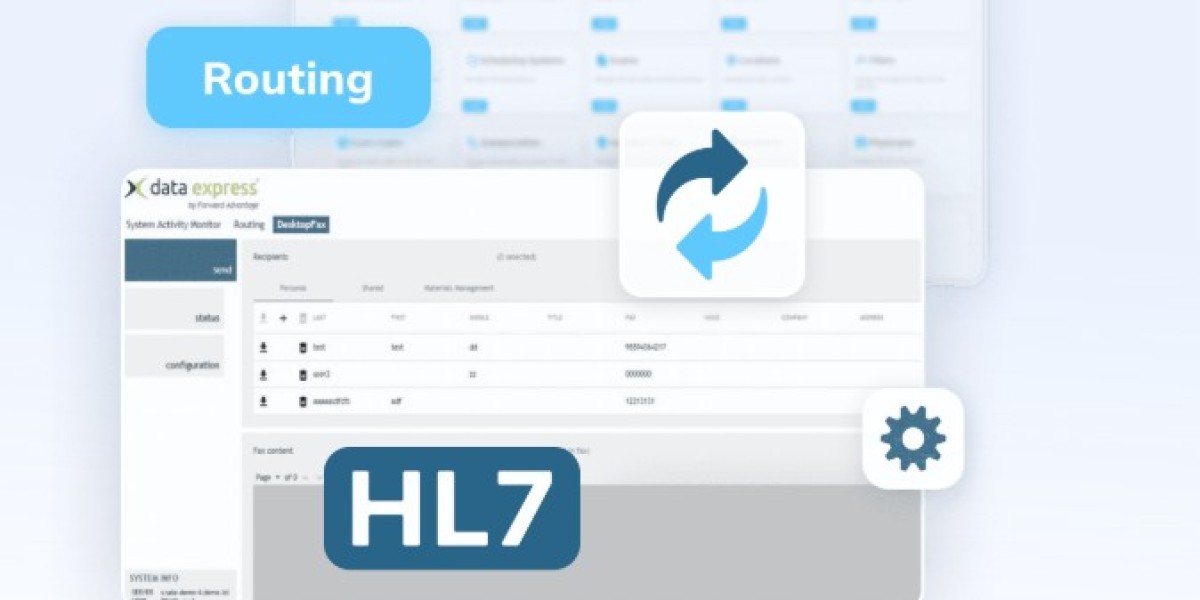The healthcare industry has undergone a tremendous digital transformation over the last few decades, with information exchange becoming central to improving care quality and operational efficiency. One of the key technologies enabling this transformation is the Health Level 7 (HL7) interface, a messaging standard that facilitates the exchange of electronic health information across various healthcare systems. HL7 interfaces allow different healthcare software applications, devices, and systems to communicate seamlessly, ensuring that patient data is accurate, up-to-date, and easily accessible.
As healthcare continues to evolve, HL7 interface development is also advancing. The future of HL7 interface development will be shaped by emerging trends, innovations, and changing regulatory requirements. In this article, we’ll explore the future of HL7 interface development, highlighting the key trends, challenges, and technologies that healthcare organizations should keep an eye on.
What is HL7 Interface Development?
Before diving into future trends, it’s important to understand what HL7 interface development entails. HL7, a non-profit organization, developed a set of standards for the exchange, integration, sharing, and retrieval of electronic health information. The HL7 interface refers to the software and system components that enable communication between different healthcare applications, such as electronic health records (EHR), laboratory information management systems (LIMS), and radiology systems, using the HL7 messaging standard.
HL7 interfaces are essential for ensuring that healthcare data is shared accurately and efficiently across systems. The standard messages used in HL7 interface development are designed to enable real-time communication, allowing healthcare professionals to make informed decisions based on the latest patient information.
Key Trends in HL7 Interface Development
1. Adoption of HL7 FHIR (Fast Healthcare Interoperability Resources)
HL7's original messaging standard, while still widely used, has limitations when it comes to modern healthcare needs. To address these limitations, HL7 introduced the Fast Healthcare Interoperability Resources (FHIR) standard. FHIR is designed to be more flexible, efficient, and adaptable to the rapidly evolving healthcare ecosystem.
FHIR focuses on a modular approach to data exchange, breaking down healthcare data into smaller, more manageable components called "resources." These resources can be easily accessed and manipulated through modern web technologies like RESTful APIs. FHIR enables easier integration between different healthcare systems, and its use of web standards like HTTP, XML, and JSON makes it more compatible with contemporary development practices.
The future of HL7 interface development is expected to see widespread adoption of FHIR as a more efficient alternative to traditional HL7 standards. Healthcare organizations will increasingly move towards FHIR-based interfaces to support interoperability, reduce the complexity of integrations, and improve data exchange efficiency.
2. AI and Machine Learning Integration
Artificial intelligence (AI) and machine learning (ML) are making waves across various industries, and healthcare is no exception. HL7 interfaces are being enhanced with AI and ML capabilities to process and interpret health data more intelligently.
AI can help analyze large volumes of health data that flow through HL7 interfaces, offering insights into patient outcomes, predicting disease progression, and assisting in clinical decision-making. Machine learning models can be integrated into HL7 interfaces to automate tasks like data validation, anomaly detection, and workflow optimization. For example, AI-powered systems can flag potential errors in patient data or suggest clinical interventions based on patterns observed in real-time data.
In the future, we can expect a greater integration of AI and ML into HL7 interface development, which will lead to more intelligent, data-driven systems that improve healthcare outcomes and operational efficiency.
3. Cloud-Based HL7 Integration
Cloud computing is revolutionizing healthcare IT by offering scalable, cost-effective, and flexible solutions for data storage, processing, and sharing. Cloud-based HL7 interfaces are becoming increasingly popular because they eliminate the need for on-premises hardware, reducing the burden on healthcare organizations' IT departments.
With cloud-based HL7 interfaces, healthcare organizations can easily connect their systems and share patient data with external providers, specialists, and payers. Cloud platforms enable real-time data sharing and collaboration across multiple healthcare entities, making it easier to provide coordinated care and improve patient outcomes.
As more healthcare organizations adopt cloud technologies, we will see an increase in the number of HL7 interfaces hosted in the cloud. This shift will lead to improved scalability, faster implementation, and enhanced data security, which is crucial for ensuring patient privacy.
4. Patient-Centered Interoperability
Traditionally, healthcare data exchange has been centered around healthcare providers and systems. However, the future of HL7 interface development is shifting towards a more patient-centered approach. With patients becoming more proactive in managing their health, there is a growing demand for healthcare systems that allow individuals to access and control their own health data.
The future of HL7 interfaces will focus on creating seamless interoperability between various healthcare systems and patients' personal health records (PHRs). This could involve integrating HL7 interfaces with mobile apps, wearable devices, and other consumer health technologies. By allowing patients to access their health information from multiple sources and share it with providers, HL7 interfaces will help promote patient engagement and improve health outcomes.
5. Blockchain for Data Security and Integrity
Data security and integrity are paramount in healthcare, given the sensitive nature of health information. As cyber threats evolve, healthcare organizations are seeking innovative solutions to protect patient data and ensure its authenticity.
Blockchain technology, known for its decentralized, tamper-proof nature, holds significant potential for securing healthcare data exchanges. By integrating blockchain with HL7 interfaces, healthcare organizations can create more secure and transparent data-sharing mechanisms. Blockchain can provide an immutable record of health data exchanges, ensuring that patient information is not altered or tampered with during transmission.
While the adoption of blockchain in healthcare is still in its early stages, it is likely to play a key role in the future of HL7 interface development, particularly in ensuring the security and integrity of health data.
6. Regulatory Compliance and Standardization
The healthcare industry is heavily regulated, with various laws and standards governing the exchange of patient data. Regulations such as the Health Insurance Portability and Accountability Act (HIPAA) in the United States, as well as the General Data Protection Regulation (GDPR) in Europe, set strict guidelines for how patient information should be protected and shared.
As healthcare systems evolve, HL7 interfaces must be designed to comply with these regulations. The future of HL7 interface development will involve a greater emphasis on ensuring that data exchanges meet regulatory standards, including those related to data security, privacy, and consent management.
Innovations in HL7 interface development will also include the development of tools and frameworks that help healthcare organizations stay compliant with regulatory requirements. This could involve automated compliance checks, data encryption, and secure authentication methods built into HL7 interfaces.
Challenges in HL7 Interface Development
While the future of HL7 interface development looks promising, there are several challenges that healthcare organizations must address to ensure successful implementation and interoperability:
1. Data Fragmentation
One of the biggest challenges in HL7 interface development is the fragmentation of health data across multiple systems, formats, and platforms. Healthcare organizations often use a mix of legacy systems, modern software, and third-party applications, leading to data silos that make it difficult to achieve true interoperability.
Future HL7 interfaces must be designed to bridge these gaps and integrate disparate systems seamlessly. This may require additional investment in data mapping, transformation tools, and system modernization.
2. Integration Complexity
As healthcare systems become more complex and diversified, integrating various technologies and applications via HL7 interfaces becomes more challenging. Developers will need to ensure that interfaces can handle complex workflows and provide real-time data synchronization across multiple systems.
This complexity is further compounded by the shift towards FHIR-based interfaces, which requires developers to adopt new skills and practices. As FHIR adoption grows, HL7 interface development will need to evolve to accommodate both traditional HL7 standards and the newer FHIR framework.
3. Data Privacy and Security Concerns
With the increasing volume of sensitive health data being exchanged, data privacy and security remain top priorities. Ensuring that HL7 interfaces comply with privacy laws and prevent unauthorized access to patient information is a significant challenge.
To overcome this challenge, HL7 interface developers must prioritize encryption, authentication, and access control mechanisms in their designs. Additionally, ongoing security audits and vulnerability testing will be necessary to mitigate the risk of data breaches.
Conclusion
The future of HL7 interface development is filled with opportunities and challenges. As healthcare continues to embrace digital transformation, HL7 interfaces will play a critical role in facilitating seamless data exchange, improving patient care, and enabling innovative healthcare solutions. Trends such as the adoption of HL7 FHIR, AI and ML integration, cloud-based platforms, patient-centered interoperability, blockchain security, and regulatory compliance will shape the future of HL7 interface development.
However, to fully realize the potential of these innovations, healthcare organizations will need to overcome challenges such as data fragmentation, integration complexity, and privacy concerns. By addressing these challenges head-on and embracing emerging technologies, HL7 interface development can continue to drive the healthcare industry towards a more interoperable, efficient, and patient-centric future.
Naijamatta is a social networking site,
download Naijamatta from Google play store or visit www.naijamatta.com to register. You can post, comment, do voice and video call, join and open group, go live etc. Join Naijamatta family, the Green app.
Click To Download
